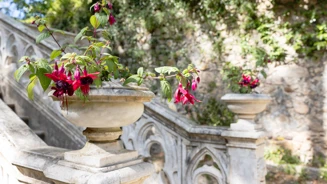Parques de Sintra plants more than 700 specimens of ‘lady's eardrops’ in the Park of Monserrate
03 Jun 2024
As part of the ongoing work of renewing the botanical collections that Parques de Sintra promotes in the historic gardens under its management, more than 700 specimens of cultivars from three species of fuchsia (Fuchsia magellanica, Fuchsia boliviana and Fuchsia koralle), commonly known as ‘lady's eardrops,’ developed in the second half of the 19th century, were planted in the Park of Monserrate.
Originally from South America, fuchsias contribute to the recreation of tropical landscapes full of exoticism, as befitted the romantic spirit that dominated Europe from the mid-19th century onwards. It is therefore very likely that they were already on the list of botanical species in the Park of Monserrate at the time of Francis Cook, the wealthy English merchant who acquired the property in 1863. What is certain is that, in the first quarter of the 20th century, these plants were already present in the space, as in a guide to visiting the gardens dated 1923, head gardener Walter Oates mentions the existence of several very old fuchsias in the Entrance Garden, in the Fern Valley and around the Palace.
The planting of fuchsias, now completed, contributes to the recovery and enhancement of the Park of Monserrate, which Parques de Sintra has been carrying out since 2000, with the aim of restoring and maintaining the botanical interest, ambiance and amazement that the space provoked among visitors and guests of the Cook family in the 19th century.
At the same time, and with the same purpose, 200 specimens of Begonia belleconia were planted in the flower boxes on the balustrade of the Palace of Monserrate in May. Using specimens grown in the Monserrate greenhouse, plants that did not survive the winter and annual species with seasonal flowering, including sage, succulents, agaves and bromeliads, have also been replanted.

